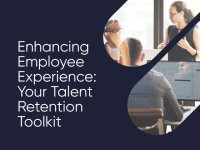6 innovative use cases of generative AI in contact centers
Generative AI is changing contact centers by adapting in real time and generating content on demand. Ready to turn AI into action across your contact ...
Solutions
Products
Customers
Solutions
Products
Customers
Resources
Company
The Team at CallMiner
May 09, 2019


Updated May 31, 2022
Agent or employee engagement is a vital topic in call center management. Many contact centers are new to defining what employee engagement looks like, measuring, and figuring out how to tie employee performance to overall company goals. In a recent webinar nGuvu’s Pascal Leclerc on the top 10 employee engagement trends of 2019, we discussed an in-depth look at employee engagement, top trends to consider in 2019, and how to build employees in your contact center. Below are a few of our polls and audience questions answered!
Employee engagement can be defined in several ways including agency satisfaction surveys, employee retention and employee performance to name a few. During the webinar, we polled attendees on how they define employee engagement. Employee performance was the main factor that businesses use to determine employee engagement with 35.64% of the votes.

Employee engagement is the level of psychological investment in the organization. This includes the buy-in, how strongly they feel about the organization they work. There is an associated cost with lack of employee engagement including:
These consequences for not having engaged employees can be detrimental to your organization if not acted on. These days employee engagement is a top of mind consideration for leaders across businesses. It is more important than ever to identify the value of the workforce and provide them with the tools they need to be successful. Simply retaining employees is no longer enough.
Webinar participants were also invited to weigh in on how they measure employee engagement. Contact centers can review customer satisfaction rates, an annual employee survey, internal methodology, speech analytics, or employee turnover.
More than 45% of respondents shared that they only use annual surveys to measure engagement while another 20% use retention to measure it.
While the majority of the businesses define employee engagement by employee performance, only asking them about it at an annual employee survey is not valuable. Contact centers rely on data which makes it possible to measure employee performance and provide feedback daily.
When call centers use speech analytics software to automatically listen to, transcribe, capture, and quantify 100% of contacts versus only reviewing three to five percent of calls, they will be able to identify lack of engagement quickly. Agents require both constructive and positive feedback on how they are doing to push them to perform better.
How Can I Help Agents Learn and Develop?
A question that arose a few times in the webinar was a simple one: how can I help my agents learn and develop. Turn over rate is high for an agent and with training taking up to eight months, there is a big investment in agents. It’s very important to agents that their employer supports learning and development.
By analyzing 100% of customer interactions, you will take the guesswork out of identifying exactly where agents need help. And simply not picking only negative calls or a few from the dozens they do a day or week. This enables you to deliver tailored agent coaching rather than following generic training plans that may not be giving them the guidance they need. Supervisors can use the insight from analyzing all of their agent’s interactions with customers to create targeted training programs to ensure agents receive additional coaching to support an agent’s personal improvement objectives.
By giving every agent access to automated, daily scorecards, you can deliver fast and efficient performance feedback. This gives supervisors the opportunity to coach their agents efficiently. Perhaps more importantly, access to personal performance data (based on every interaction) also helps to create a culture of self-evaluation and improvement, as agents recognize where on the optimum customer path they could be improving their performance. For example, if the scorecard shows a need to improve empathy, the agent can focus on this during the next shift. Supervisors can also reinforce the desire to self-coach by using the daily scorecard to recognize the improvements the agent made on their previous shift.
CallMiner is the global leader in AI-powered conversation intelligence to improve customer experience (CX). CallMiner delivers the industry’s most comprehensive platform to analyze omnichannel customer interactions at scale, combining deep domain expertise with cutting edge AI analytics and machine learning. By uncovering better intelligence, CallMiner enables companies to identify areas of opportunity to drive better experiences, ultimately leading to business improvement, growth and transformational change. CallMiner is trusted by the world’s leading organizations across all major verticals including technology, media and telecom (TMT), retail, manufacturing, financial services, healthcare, and travel and hospitality.